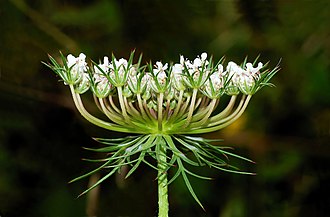Umbel
Type of inflorescence

An umbel is a type of inflorescence that is characteristic of the Apiaceae family, although it can be found in other plant families as well. In an umbel, the individual flower stalks, known as pedicels, arise from a common point, much like the ribs of an umbrella. This structure can be simple or compound, with the latter having secondary umbels, or umbellets, branching off the main stalks.
Structure[edit]
Umbels can vary in size and complexity. A simple umbel consists of a single layer of pedicels that radiate from a central point. In contrast, a compound umbel has multiple layers, with each primary pedicel supporting a secondary umbel. This arrangement is particularly common in the Apiaceae family, which includes well-known plants such as Daucus carota (carrot) and Conioselinum pacificum.

The structure of an umbel allows for efficient pollination, as the flowers are presented in a flat or slightly rounded cluster, making them easily accessible to pollinators such as bees and butterflies. The uniformity of the flower arrangement also aids in the dispersal of seeds.
Examples[edit]
Several plant species exhibit umbel inflorescences. Some notable examples include:
- Daucus carota, commonly known as Queen Anne's lace, is a wild carrot species with a characteristic white umbel.
- Conioselinum pacificum, known as Pacific hemlock-parsley, features compound umbels typical of the Apiaceae family.
- Fatsia japonica, although not in the Apiaceae family, displays umbels in its flowering structure.
- Primula veris, or cowslip, is another example of a plant with umbel-like inflorescences.
- Pelargonium zonale, a type of geranium, also exhibits umbel formations.

Ecological Significance[edit]
Umbels play a significant role in the ecology of their environments. The open and accessible structure of the umbel makes it an attractive target for a variety of pollinators. This can lead to increased genetic diversity and successful reproduction for the plants. Additionally, the dense clustering of flowers can provide a visual signal to pollinators from a distance.
Related pages[edit]
Ad. Transform your life with W8MD's Budget GLP-1 injections from $75


W8MD offers a medical weight loss program to lose weight in Philadelphia. Our physician-supervised medical weight loss provides:
- Weight loss injections in NYC (generic and brand names):
- Zepbound / Mounjaro, Wegovy / Ozempic, Saxenda
- Most insurances accepted or discounted self-pay rates. We will obtain insurance prior authorizations if needed.
- Generic GLP1 weight loss injections from $75 for the starting dose.
- Also offer prescription weight loss medications including Phentermine, Qsymia, Diethylpropion, Contrave etc.
NYC weight loss doctor appointmentsNYC weight loss doctor appointments
Start your NYC weight loss journey today at our NYC medical weight loss and Philadelphia medical weight loss clinics.
- Call 718-946-5500 to lose weight in NYC or for medical weight loss in Philadelphia 215-676-2334.
- Tags:NYC medical weight loss, Philadelphia lose weight Zepbound NYC, Budget GLP1 weight loss injections, Wegovy Philadelphia, Wegovy NYC, Philadelphia medical weight loss, Brookly weight loss and Wegovy NYC
|
WikiMD's Wellness Encyclopedia |
| Let Food Be Thy Medicine Medicine Thy Food - Hippocrates |
Medical Disclaimer: WikiMD is not a substitute for professional medical advice. The information on WikiMD is provided as an information resource only, may be incorrect, outdated or misleading, and is not to be used or relied on for any diagnostic or treatment purposes. Please consult your health care provider before making any healthcare decisions or for guidance about a specific medical condition. WikiMD expressly disclaims responsibility, and shall have no liability, for any damages, loss, injury, or liability whatsoever suffered as a result of your reliance on the information contained in this site. By visiting this site you agree to the foregoing terms and conditions, which may from time to time be changed or supplemented by WikiMD. If you do not agree to the foregoing terms and conditions, you should not enter or use this site. See full disclaimer.
Credits:Most images are courtesy of Wikimedia commons, and templates, categories Wikipedia, licensed under CC BY SA or similar.
Translate this page: - East Asian
中文,
日本,
한국어,
South Asian
हिन्दी,
தமிழ்,
తెలుగు,
Urdu,
ಕನ್ನಡ,
Southeast Asian
Indonesian,
Vietnamese,
Thai,
မြန်မာဘာသာ,
বাংলা
European
español,
Deutsch,
français,
Greek,
português do Brasil,
polski,
română,
русский,
Nederlands,
norsk,
svenska,
suomi,
Italian
Middle Eastern & African
عربى,
Turkish,
Persian,
Hebrew,
Afrikaans,
isiZulu,
Kiswahili,
Other
Bulgarian,
Hungarian,
Czech,
Swedish,
മലയാളം,
मराठी,
ਪੰਜਾਬੀ,
ગુજરાતી,
Portuguese,
Ukrainian